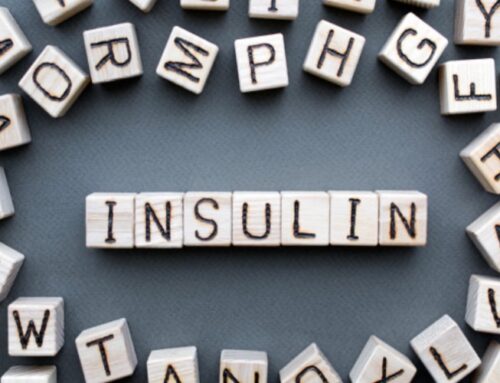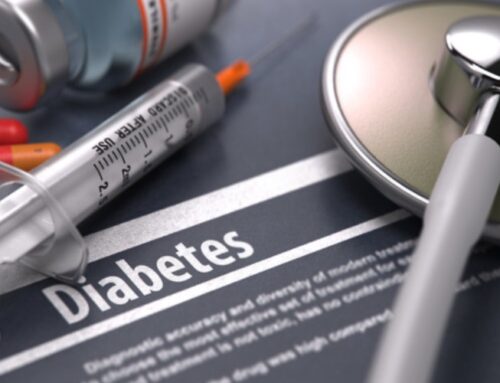When you hear the word insulin, what comes to mind? Have you ever thought much about the role of insulin in your body? Turns out, high insulin levels are one of the driving factors in why we gain weight, get heart disease (e.g., high cholesterol, high blood pressure), metabolic syndrome, type 2 diabetes, PCOS, thyroid dysfunction, cancer, and obesity, to name a few. Let me explain.
Insulin is an anabolic, building storing hormone known as the “master” hormone. Hormones are basically messengers in the body that tell things what to do and where to go in order for our body to stay in balance and function well. In the case of insulin, it is made in the pancreas and is released in response to rising levels of blood sugar.
So, how does blood sugar rise? When we eat carbohydrates, especially refined, processed ones like bread, cereal, chips, crackers, rice, pasta, candy, soda and other sugar-sweetened beverages, corn and sugar, blood sugar levels rise tremendously. Insulin is then released from the pancreas in response to rising blood sugar levels and comes and takes the sugar from the blood to our body cells to store for use for energy later. The more carbohydrates, and the more often we eat, the more insulin is released. When we eat eggs, avocado, nuts, meats, and other low-or-no-carbohydrate foods hardly any insulin is released because there are few carbohydrates in those foods. Whereas, when we eat the aforementioned high carb foods, a lot of insulin is released because those foods are much higher in carbohydrates.
The process works fine until our cells become too full of sugar. Because of our tendency to overconsume, especially refined carbohydrates, our cells eventually become too full of sugar. We develop an energy storage problem. To protect themselves from damage due to toxic levels of sugar, they start ignoring insulin’s message to store sugar, becoming insulin resistant. The pancreas senses this and produces more insulin to keep blood sugar levels down. In someone who is insulin resistant, the pancreas releases 3-5 times more insulin to bring blood sugar to normal levels than someone who is insulin sensitive. When the storage problem arises and insulin has trouble moving the sugar from the blood stream into the cells, high blood sugar develops often eventually leading to type 2 diabetes.
I like to give this analogy to explain what happens in the body at the cellular level as we develop insulin resistance. This is a very simplified explanation, but it gives you a visual. Imagine you are in a hotel, and you go to get on the elevator. There is a bellman there and his job is to get people on the elevator, just as insulin’s job is to get sugar into the cells. The elevator door opens and it so full of people not even a baby could fit but the bellman is telling you and your friends to come get on. The elevator knows if it lets any more people on, it will break so it shuts its door and does not allow the bellman to open it to let any more people in. The cells are similar, they detect their storage capacity for sugar is maxed out and if anymore comes in, they will become damaged, so they resist insulin’s message to store sugar and become insulin resistant. Going back to the elevator example, the bellman then goes and gets his friends to help pry open the elevator door to get more people in. In a similar manner, the pancreas begins to produce more and more insulin to overcome the insulin resistance and pack more sugar into the cells. This is also how the blood levels of insulin become elevated which is associated with a myriad of chronic diseases, mentioned at the beginning of this article. Once someone develops insulin resistance, it takes 3-5 times more insulin to move the same amount of sugar into the cells as someone who is insulin sensitive, thus frequently elevated blood levels of insulin develop.
Just as high blood sugar levels are dangerous, long-term high blood levels of insulin are also dangerous. Unfortunately, many doctors don’t measure or talk about this as much. If we can address insulin resistance when it first develops, it is much easier to reverse so that a person can once again be insulin sensitive. High insulin levels cause damage to the heart and the cardiovascular system and promote weight gain. The more insulin floating around in the blood stream, the more fat we store which leads to weight gain. Insulin stimulates the uptake of fatty acids by fat cells, which convert these molecules into triglycerides — the primary storage form of fat in your body. Thus, insulin promotes lipogenesis, the creation of new fat.
Said another way, when our body has too much sugar that needs to be stored because we overconsume carbohydrates and are not very active, insulin essentially changes sugar into triglycerides through a process called lipogenesis and stores it in our fat cells causing weight gain, leading to a whole host of other problems including metabolic syndrome and often eventually leading to type 2 diabetes. Another reason elevated insulin levels are problematic is that high levels of insulin block nutrient absorption thus causing nutrient deficiencies. It is common to see things like low potassium and low Vitamin D in people who have insulin resistance.
When our cells start ignoring insulin’s message to store sugar, the pancreas produces more insulin to compensate for that to keep blood sugar levels down. Therefore, more insulin is present in the blood stream, leading to excess storage, weight gain, and host of other complications. Further, elevated insulin levels contribute to hardening of the arteries and constricts blood vessels causing high blood pressure. In fact, a very early warning sign of insulin resistance and the development of type 2 diabetes in some people is high blood pressure.
This whole process starts when we overCARBsume certain foods. Once we are insulin resistant, inflammation and other problems arise, including weight gain, metabolic syndrome, and type 2 diabetes. Lowering our insulin levels is the real key to weight loss, weight management, sustained weight loss, reversing certain chronic health conditions and the damage done to our bodies. To lower insulin levels and improve your body’s sensitivity to insulin, you need to consume less carbohydrates and try to limit things like grains, bread, cereal, pasta, sugar sweetened beverages and other refined and processed carbohydrates. Fasting is also a great tool to lower insulin levels and promote insulin sensitivity.
So how do you know if you have high insulin levels or if you are insulin resistant? There are several ways to tell. If you have any of the following, you may have high insulin levels and/or insulin resistance: extra body weight especially around the stomach, a fasting blood sugar above 100, an A1C above 5.4, high cholesterol, high blood pressure, high triglycerides, muscle weakness, fatigue (tiredness), cognitive brain fog, loss of memory, vision problems, headaches, artery inflammation, skin tags, acne, PCOS, gout, fatty liver, obesity, thyroid disfunction, not satisfied after eating, nutrient deficiencies, often feel hungry (cells are not well fed), and leptin resistance.
Food can be your medicine. If you suspect you have or may be developing insulin resistance, consider changing your diet to include anti-inflammatory low-carbohydrate foods such as non-starchy vegetables, eggs, meats, fish, nuts, and healthy fats. If you have questions or would like more information, please don’t hesitate to reach out to me.






